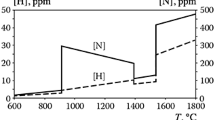Special features of a recent metallurgical process for structural steels are considered. The types of nonmetallic inclusions, precipitates of excess phases and impurities are described, and the effect of their content, size, morphology and volume distribution on the production, operational and quality characteristics of the steel is determined. Specific examples are used to show the perspectives of the formulated principle for advancing the combination of properties of structural steels of various types at substantial decrease in the expenses.






Similar content being viewed by others
References
A. I. Zaitsev, K. L. Kosyrev, and I. G. Rodionova, “Recent tendencies of development of metallurgical technology for attaining a set of high operating properties and quality parameters in steel,” Probl. Chern. Metall. Materialoved., No. 3, 5 – 13 (2012).
E. Kh. Shakhpazov, A. I. Zaitsev, I. G. Rodionova, and G. V. Semernin, “Key directions of the development of metallurgical technology for meeting the tightening requirements on the quality of steel,” Élektrometallurgiya, No. 2, 2 – 12 (2011).
E. Kh. Shakhpazov, A. I. Zaitsev, and I. G. Rodionova, “Recent problems of the metallurgy and materials science of steels,” Metallurg, No. 4, 25 – 31 (2009).
E. Kh. Shakhpazov, A. I. Zaitsev, I. G. Rodionova, and N. G. Shaposhnikova, “Nanotechnologies of the production of mass high-quality steels based on control of nanosize precipitates of nonmetallic excess phases,” Probl. Chern. Metall. Materialoved., No. 4, 112 – 122 (2008).
Y. Funakawa, et al., “Development of high strength hot-rolled steel sheet consisting of ferrite and nanometer-sized precipitates,” ISIJ Int., 44(11), 1945 – 1951 (2004).
A. I. Zaitsev, I. G. Rodionova, G. V. Semernin, et al., “New types of unfavorable nonmetallic inclusions based on MgO – Al2O3 and metallurgical factors determining their content in the metal. Part 1,” Metallurg, No. 2, 50 – 55 (2011).
I. G. Rodionova, A. I. Zaitsev, O. N. Baklanova, et al., Modern Approaches to Raising the Corrosion Resistance and Operating Reliability of Steels for Oil-Field Pipelines [in Russian], Metallurgizdat, Moscow (2012), 172 p.
G. V. Semernin, A. I. Zaitsev, and I. G. Rodionova, “Advancement of the processes of ladle treatment and continuous casting for providing the purity of steels with respect to new unfavorable types of nonmetallic inclusions,” in: Proc. XI Congr. of Steel Melters (Nizhny Tagil, 3 – 8 Oct. 2010) [in Russian], MOO “Association of Steel Melters,” Nizhny Tagil (2011), Pt. II, pp. 349 – 355.
I. G. Rodionova, A. I. Zaitsev, G. V. Semernin, et al., “Scientific and technological foundations of the production of low-alloy steels with high parameters of resistance to local corrosion and operating reliability in aqueous chlorine-containing environments,” Probl. Chern. Metall. Materialoved., No. 3, 65 – 73 (2011).
A. I. Zaitsev, I. G. Rodionova, O. N. Baklanova, et al., “A study of the effect of metallurgical factors on the resistance of modern pipe steels to corrosion cracking,” Probl. Chern. Metall. Materialoved., No. 1, 54 – 69 (2013).
E. Kh. Shakhpazov, A. I. Gordienko, A. I. Zaitsev, et al., “Raising the level and stability of mechanical and other operating characteristics of automotive sheet steels by controlling the processes of segregation of excess phases,” Metallurg, No. 9, 40 – 46 (2009).
A. I. Zaitsev, I. G. Rodionova, N. G. Shaposhnikov, et al., “Development of scientific foundations for effective production processes for cold-rolled high-strength low-alloy steels by controlling the type, content and morphology of segregations of nonmetallic excess phases,” Probl. Chern. Metall. Materialoved., No. 1, 75 – 85 (2012).
A. I. Zaitsev, I. G. Rodionova, N. A. Karamysheva, et al., “Optimization of the process of production of automotive sheet steel 08Yu on the basis of physicochemical principles of ladle treatment of steel,” Metallurg, No. 8, 58 – 65 (2007).
P. A. Mishnev, Raising the Quality of Cold-Rolled Strip from Low-Carbon Steel with Different Contents of Impurities by Controlling Structure Formation in Recrystallization Annealing in Ball Furnaces, Author’s Abstract of Candidate’s Thesis [in Russian], FGUP “TSNIIchermet Im. I. P. Bardina,” Moscow (2012), 28 p.
E. Kh. Shakhpazov, A. I. Zaitsev, and I. G. Rodionova, “Modern tendencies of development of metallurgical technology and aspects of raising of the properties and reliability of metalware, The problem of nonmetallic inclusions in steel,” Probl. Chern. Metall. Materialoved., No. 3, 11 – 20 (2009).
I. G. Rodionova, N. G. Shaposhnikov, N. I. Éndel’ et al., “Conditions of formation of nitride and sulfide phases in steels for deep drawing,” Probl. Chern. Metall. Materialoved., No. 3, 60 – 67 (2008).
N. A. Arutyunyan, A. I. Zaitsev, and O. N. Baklanova, “A study of the principles of creation of steels for manufacturing high-strength reliable articles by methods of hot forming,” Metallurg, No. 11, 55 – 61 (2014).
T. Hara, H. Asahi, R. Uemori, and H. Tamehiro, “Role of combined addition of niobium and boron and of molybdenum and boron on hardenability in low carbon steels,” ISIJ Int., 44(8), 1431 – 1440 (2004).
B. Hwang, D.-W. Suh, and S.-J. Kim, “Austenitizing temperature and hardenability of low-carbon boron steels,” Scr. Mater., 64(12), 1118 – 1120 (2011).
C. A. Suski and C. A. S. Oliveira, “Effect of austenitization temperature on the precipitation of carbides in quenched low carbon born steel,” Metallogr., Microstr., Analysis, 2, 79 – 87 (2013).
M. J. Kim, H. H. Cho, S. H. Ki, et al., “Effect of Zr addition on phase transformation and precipitation in B-added hot stamping steel,” Metall. Mater. Int., 19(4), 629 – 635 (2013).
K. Cho, D. J. Mun, Y. M. Koo, and J. S. Lee, “Effect of niobium and titanium addition on the hot ductility of boron containing steel,” Mater. Sci. Eng. A, 528, 3556 – 3561 (2011).
A. I. Zaitsev, I. G. Rodionova, A. A. Bykov, et al., “A study of the properties and operating characteristics of bimetallic materials with nanostructured wear-resistant cladding layer,” Probl. Chern. Metall. Materialoved., No. 2, 70 – 75 (2012).
Yu. I. Matrosov, D. A. Litvinenko, and S. A. Golovanenko, Steel for Delivery Pipelines [in Russian], Metallurgiya, Moscow (1989), 289 p.
I. G. Rodionova, A. I. Zaitsev, N. G. Shaposhnikov, et al., “Effect of chemical composition and production parameters on formation of nanostructure component and combination of properties of high-strength low-alloy structural steels,” Metallurg, No. 6, 3 – 39 (2010).
Youn-BaeKang and Hae-GeonLee, “Inclusions chemistry for Mn/Si deoxidized steels: thermodynamic predictions and experimental confirmations,” ISIJ Int., 44(6), 1006 – 1015 (2004).
A. I. Zaitev, I. G. Rodionova, O. N. Baklanova, et al., “New types of nonmetallic inclusions in structural steels and special features of their effect on the structural state of the metal of continuously cast preforms and on the final properties of rolled stock,” Metallurg, No. 11, 63 – 69 (2014).
A. I. Zaitsev, B. M. Mogutnov, and E. Kh. Shakhpazov, The Physical Chemistry of Metallurgical Slags [in Russian], Intercontact Nauka, Moscow (2008), 352 p.
A. I. Zaitsev, I. G. Rodionova, A. A. Nemtinov, et al., “Control of nonmetallic inclusions: key problem of modern metallurgy and material science of steel and iron alloys,” Probl. Chern. Metall. Materialoved., No. 1, 11 – 23 (2007).
E. Kh. Shakhpazov, A. I. Zaitsev, N. G. Shaposhnikov, and I. G. Rodionova, “Models of control of processes of ladle treatment of steel,” Metallurg, No. 6, 30 – 35 (2008).
R. Kh. Shakhpazov, A. I. Zaitsev, and I. G. Rodionova, “Production engineering of bulk high quality steels based on controlling nanosized precipitations of nonmetallic excessive phases (inclusions); 10th China – Russia Symp. on Advanced Materials and Technologies, Jiaxin, China, Oct. 20 – 24, 2009,” Rare Metals, 28, Spec. Issue, 74 – 77 (2009).
E. Kh. Shakhpazov, A. I. Zaitsev, amd I. G. Rodionova, “Recent problems of the metallurgy and material science of steel,” Metallurg, No. 4, 25 – 31 (2009).
The study has been performed within a grant of the Russian Research Foundation (Project No. 14-19-01726) at the I. P. Bardin Central Research Institute for Ferrous Metallurgy.
Author information
Authors and Affiliations
Corresponding author
Additional information
Translated from Metallovedenie i Termicheskaya Obrabotka Metallov, No. 9, pp. 13 – 20, September, 2015.
Rights and permissions
About this article
Cite this article
Zaitsev, A.I., Stepanov, A.B., Karamysheva, N.A. et al. Advancement of the Properties of Structural Steels by Creating an Optimum Form of Existence of Impurities and Nonmetallic Inclusions. Met Sci Heat Treat 57, 531–538 (2016). https://doi.org/10.1007/s11041-016-9917-7
Published:
Issue Date:
DOI: https://doi.org/10.1007/s11041-016-9917-7




